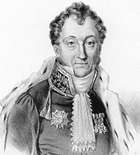Mathieu de Montmorency


Mathieu Jean Felicité de Montmorency, duc de Montmorency-Laval (10 July 1767 – 24 March 1826) was a prominent French statesman during the French Revolution and Bourbon Restoration.
Early years
Born in Paris, Mathieu de Montomorency was the son of Mathieu Paul Louis de Montmorency, vicomte de Laval (1748–1809), a scion of one of the oldest noble families in France, and his wife, Catherine Jeanne Tavernier de Boullongne (d. 1838), the daughter of an aristocratic French planter in Guadeloupe. His mother's illegitimate mulatto half-brother was the famous Chevalier de Saint-Georges. His father, a colonel of the Auvergne regiment, was appointed a premier gentilhomme de la chambre to King Louis XVI of France's younger brother, the Comte de Provence, in 1780. However, when Catherine was denied the corresponding rank of dame pour accompagner to the prince's wife, Marie-Joséphine, due to her relatively low birth, Laval resigned his post in Provence's household.
Career
Originally known by the title of Comte de Montmorency-Laval, Mathieu served as an adolescent with his father in the American Revolution and returned to France imbued with democratic ideals. He was the Governor of Compiègne when he was elected as a deputy for the noblesse to the Estates-General in 1789, where, at the opening of the French Revolution, he joined the Third Estate and sat on the left side of the National Assembly. He initiated the abolition of coats-of-arms on 19 June 1790. The dissolution of the National Constituent Assembly in September 1791 set him free to join Nicolas Lückner's army on the frontier early in the next year. After the storming of the Tuileries Palace on 10 August 1792, he abandoned his revolutionary principles and fled to Switzerland and later to Great Britain. In 1795, he returned to Paris but took no part in politics under the Directory, Consulate, or Empire.
At the beginning of the Bourbon Restoration, he was promoted to the rank of maréchal de camp, and accompanied Louis XVIII to Ghent during the Hundred Days. After the Battle of Waterloo and the final defeat of Napoleon in 1815, he was made a peer of France and received the title of Vicomte de Montmorency-Laval. He was instrumental in convincing Armand-Emmanuel du Plessis, Duc de Richelieu to replace his former friend and former Bonapartist Charles Maurice de Talleyrand-Périgord as the new Prime Minister of France.
Known for strong reactionary, ultramontane, and Ultra-royalist views, he became the French minister of foreign affairs under Jean-Baptiste Guillaume Joseph, comte de Villèle in December 1821. He recommended armed intervention in Spain, to restore Ferdinand VII, at the Congress of Verona in October 1822, but he resigned his post in December, being compensated by the title of Duc de Montmorency-Laval and the cross of the Legion of Honour soon after.
Death
He was elected to the Académie française in 1825, with few qualifications for the honour, and in the following year, he was named tutor to the six-year-old heir to the throne, the Duc de Bordeaux. He died two months after receiving this prestigious appointment, on 24 March 1826. He was discovered seated lifeless at the end of the Good Friday Liturgy in St. Thomas d'Aquin church in the fashionable St. Germain des Près faubourg..
References
 This article incorporates text from a publication now in the public domain: Chisholm, Hugh, ed. (1911). "article name needed". Encyclopædia Britannica (11th ed.). Cambridge University Press.
This article incorporates text from a publication now in the public domain: Chisholm, Hugh, ed. (1911). "article name needed". Encyclopædia Britannica (11th ed.). Cambridge University Press.
See Vétillard, Notice sur la vie de M. le duc Mathieu de Montmorency (Le Mans, 1826), and, for his curious relations with Mme de Staël, P Gautier, Mathieu de Montmorency et Mme de Staël, d'après les lettres inédites de M. de Montmorency à Mme Necker de Saussure (1908); Madame de Boigne (Adélaïde d'Osmond) Mémoires: Récits d'une tante, Mercure de France,t.2
